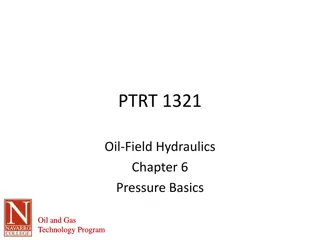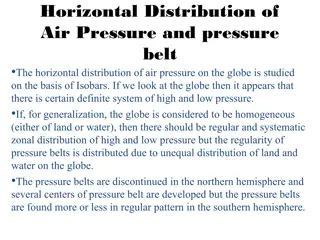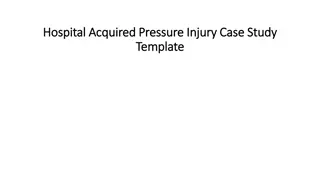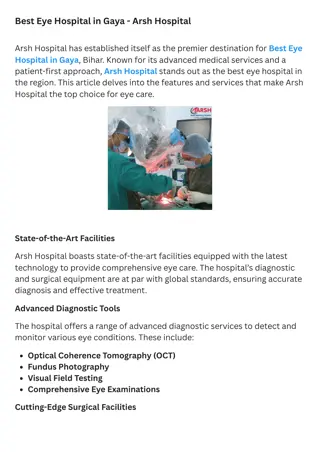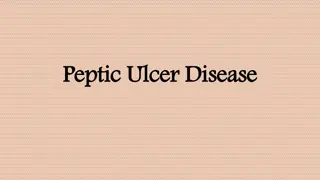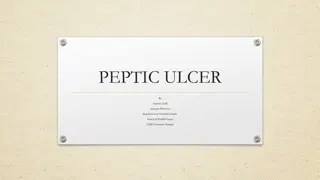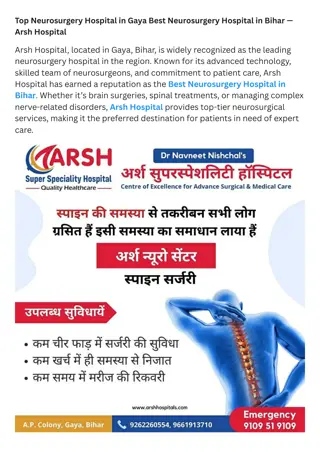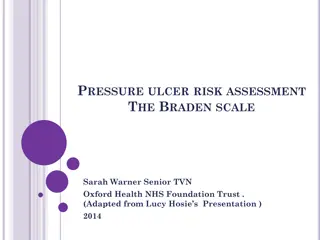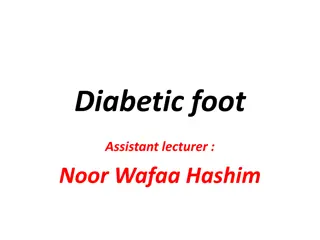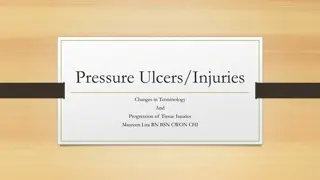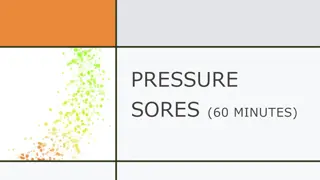Strategies to Reduce Pressure Ulcers in Hospital Patients
Hospital-acquired pressure ulcers (HAPUs) are a significant issue affecting patient outcomes and healthcare costs. Factors contributing to HAPUs include immobility, comorbidities, and older age. Implementing patient-centered care, evidence-based practices, and quality improvement strategies, as outlined in the QSEN framework, can help in reducing the incidence of pressure ulcers. Educating patients about risk factors, encouraging activity, and individualizing repositioning plans are crucial steps in prevention.
Download Presentation

Please find below an Image/Link to download the presentation.
The content on the website is provided AS IS for your information and personal use only. It may not be sold, licensed, or shared on other websites without obtaining consent from the author.If you encounter any issues during the download, it is possible that the publisher has removed the file from their server.
You are allowed to download the files provided on this website for personal or commercial use, subject to the condition that they are used lawfully. All files are the property of their respective owners.
The content on the website is provided AS IS for your information and personal use only. It may not be sold, licensed, or shared on other websites without obtaining consent from the author.
E N D
Presentation Transcript
REDUCING THE INCIDENCE OF PRESSURE ULCERS IN HOSPITAL PATIENTS Student A Student B Student C Student D Student E
Overview Hospital Hospital- -acquired pressure ulcers (HAPUs) acquired pressure ulcers (HAPUs) develop from injury to the skin or underlying tissue caused by compression of soft tissue (Alderden et al., 2011) Risk factors Risk factors for developing HAPUs (Alderden et al., 2011) Increased length of stay Immobility Mechanical ventilation Multiple comorbidities especially Diabetes and Renal insufficiency Trauma/surgical patients Older age Low body mass index/poor nutritional status Hypotensive patients on vasopressors Current clinical screening tools/assessments Braden scale Braden scale tool used to assess risk for HAPU development 4 4- -stage classification system stage classification system In 2007, suspected deep tissue injury (SDTI) and "unstageable" were added to this classification system (Alderden et al., 2011)
Significance HAPU prevalence in approximately 15% of acute patients Occurrence is on the rise 79.6% increase 79.6% increase in pressure ulcer incidence in 2006, compared to 1993 (IHI, 2011) 15% of acute patients (Roe & Williams, 2014) Nearly 60,000 deaths 60,000 deaths reported annually related to HAPU complications (Roe & Williams, 2014) Negative effects on patients Negative effects on patients Increased suffering and discomfort Increased risk of infection Increased financial burden Related to longer hospital stays and possible surgery Negative effects on health care Negative effects on health care Increased hospital stays Poor patient outcomes Increased costs 2008 Medicare/Medicaid law does not allow hospital reimbursement for care, services or treatment of stage 3 or 4 HAPUs (Alderden et al., 2011) In 2011 reports estimated 11 billion dollars 11 billion dollars spent by U.S. on pressure ulcer treatment (Roe & Williams, 2014)
Quality and Safety Education for Nurses (QSEN) Competencies The QSEN framework outlines six core competencies that aim to achieve quality and safety in nursing practice 1. Patient-centered care 2. Teamwork and collaboration 3. Evidence-based Practice 4. Quality Improvement 5. Informatics QSEN Competencies related to Pressure Ulcer Reduction QSEN Competencies related to Pressure Ulcer Reduction Patient- Centered Care Evidence- Based Practice Quality Improvement
Patient-Centered Care Providing compassionate care to patients in which they are the focus and partners in their health care Educate patients on the risk for pressure ulcers Encourage patients to maintain activity as tolerated Active or passive ROM, ambulating with assistance, etc. Individualize repositioning plan The 2-hour rotation rule may be too often or too infrequent depending on the patient's condition Observe sides/positions patient favors to determine area at greatest risk Manage factors that impede HAPU prevention Pain Poor nutritional intake
Evidence-Based Practice Integrating the best and most current evidence with clinical practice experience and patient and family values. Hospitals and their health care teams should stay up-to-date on best evidence-based practices Focus on prevention and early recognition of HAPUs Educate nurses on proper use of the Braden Scale to increase interrater reliability (Roe & Williams, 2014) Teach and implement the six essential elements preventing pressure ulcers (IHI, 2011) Perform pressure ulcer admission assessment Reassess daily, or more often as needed Inspect skin daily Manage moisture on skin Optimize nutrition and hydration Minimize pressure six essential elements to
Quality Improvement (QI) Continually striving to improve health care systems by monitoring and analyzing data trends in current practices Measure the incidence of pressure ulcers and compare to similar units/hospitals Create time specific and measurable goals aimed at decreasing the occurrence of pressure ulcers in patients (IHI, 2011) Example: Reduce the incidence of new pressure ulcers in patients in the Surgical Progressive Care Unit by 50% over the next month Implement system changes on a small scale first until data measures prove significant improvement Consider the perspective of the entire health care team when implementing QI changes including nurses, doctors, physical therapy, nursing students, etc. The focus of changing processes of care should always remain on the patient and their family
Review of Literature Studies reveal that the inadequate use of preventative measures to avoid the development of pressure ulcers is a major problem in the hospital setting. Preventive strategies were used in only 66% of the patients who acquired a pressure ulcer during their hospitalization and in only 60% of the patients with existing pressure ulcers (Wann-Hansson et al., 2008). QSEN competency literature highlights the importance of education in patient safety awareness in order to have better outcomes for patients in the healthcare setting (Chenot & Daniel, 2010). Wann-Hansson et al. (2008) found that an increased focus needs to be placed on nurse training in the identification of the patients at risk for developing pressure ulcers in order for appropriate preventative measures to be implemented as soon as possible. This aligns with the importance QSEN places on the awareness of patient safety in order to improve their quality of care
Review of Literature Patients in an intensive care unit (ICU) are particularly prone to developing pressure sores, caused by severe illness and being immobile for long periods (Boyle & Green, 2001). A study on pressure ulcer incidence in ICUs found that nurses were motivated to take precautions based on the visible damage due to pressure more so than by the presence of specific risk factors (Boyle & Green, 2001). Promotion of evidenced based practice through consistent education and training of nurses is key to long term implementation of pressure ulcer prevention guidelines (Beal & Smith, 2016). The use of risk measurement tools contributed to a significant decrease in prevalence of hospital acquired pressure ulcers from 7.8% in 2005 to 1.4% in 2014 (Beal & Smith, 2016). Pressure ulcer prevention measures used in this study included: patient assessment including the Braden score, management of excess skin moisture, optimization of patient nutrition, skin hydration, and pressure minimization (Beal & Smith, 2016).
Case Study Assess, Assess, Assess! I remember learning about pressure ulcers during my first few weeks of nursing school and wondering how often I would actually encounter them. I realized just how common they were when I began my long-term care clinical. So many people had them! I had seen several stage 4 pressure ulcers reaching down to the bone. I was shocked at how prevalent they were at the facility. It was then that I truly realized the harmful effects of not rotating your patients or performing simple skin assessments every shift.
Case Study Fast-forward to Adult II clinical this spring, when I was on a cardiac PCU with a patient in her sixties. Throughout my nursing school experience, the importance of properly assessing your patients had been drilled into our brains over and over again. We were constantly practicing our assessment skills in the hospital and learning how to address the specific needs of a variety of patients. This patient of mine presented with multiple risk factors for pressure ulcers, including an increased length of stay, immobility, and diabetes. She was also incontinent and did not speak English. Therefore, communication was difficult. Her sons came to visit every day and were a tremendous help when it came to feeding their mother, cleaning her, and changing her bedding. They were incredibly attentive and understood the needs of their mother.
Case Study I cared for this patient twice, both days a week apart. While caring for my patient on the second day, I realized she needed her briefs changed. She was an overweight woman so I asked one of my classmates to assist me. This was a perfect opportunity to perform a good skin assessment on my patient. We removed the briefs, cleaned up the patient, and we then rolled her over so that I could assess her and change her into some new briefs. To my surprise, I noticed the beginning stages of a pressure ulcer. I was surprised because it was not there a week prior when I had last seen the patient. I knew that the last time I worked with her we were applying barrier cream to protect her skin. I informed my nurse of the situation and we applied an AQUACEL foam dressing.
Case Study My nurse was unaware of the ulcer and I began to wonder if previous nurses had been performing a full skin assessment on this patient. The nurse that I was following that day left it up to the patient s sons to clean the patient and change her briefs. Maybe other nurses did the same, missing out on an opportunity to assess the patient s skin in areas that are not easily seen. The patient s sons were upset about the pressure ulcer, but I was glad that I caught it when I did. I made sure to rotate the patient every couple of hours, using pillows to relieve pressure. Also, although the patient was in bed most of the time, she was sometimes able to stand and walk to the bathroom using both a walker and the assistance of another person - usually one of her sons. I encouraged them to get her sitting up in the chair as well. Without proper assessments and attention to detail, pressure ulcers can be easily missed. Since that day, I have been even more cautious than before and never forget to take preventative measures to ensure that my patients are protected from pressure ulcers.
NURSING IMPLICATIONS On Practice, Education and Research
Practice The most current nursing practice for this concern include risk assessments, appropriate monitoring, and tailoring interventions based off of risk Risk Assessments: Braden Scale- consists of six categories: sensory perception, moisture, activity, mobility, nutrition, and friction/shear. The total score can range from 6 to 23 with a lower score indicating a higher risk. Norton Scale- includes 5 subcategories: physical: condition, mental condition, activity, mobility, and incontinence. The total score ranges from 5 (high risk) to 20 (low risk). Interventions: Turn the patient on a regular schedule Help the patient be as active as possible Protect the patient s heels Use pressure-redistribution surfaces Manage moisture, nutrition, friction, and shear Advance to a higher level of risk if other major risk factors are present
Education Proper education for the clinical staff on how to prevent pressure ulcers in the hospitalized client includes things such as: Proper nutrition Skin care Use of pressure reducing devices Decreasing mechanical load (friction) Increasing the clients mobility Consistent and frequent repositioning Education on management of existing pressure ulcers is also imperative to prevent further staging. Some important pieces of management include: Cleansing: cleaned with a nontoxic solution Assessment/Staging: stages according to the National Pressure Ulcer Advisory Panel include deep tissue injury, I, II, III, IV and unstageable Debridement: removal of necrotic tissue Proper wound dressings Nutrition: includes monitoring glucose levels in diabetic patients Pain Management
Research Priorities for further study: There is significant literature on pressure ulcer prevention methods but fewer studies have been conducted on the most effective way to implement evidenced based practice in hospitals and how to maintain those practices. Further research is needed on education and training programs for nurses on prevention of hospital acquired pressure ulcers, especially training geared towards graduate nurses and new hires. There is a gap in literature on prevalence and reduction strategies of pressure injuries occurring in the residential care setting, and how this contributes to subsequent hospitalizations and increased health care costs. Depending on patient capability to participate in their own care, further research is needed to determine if patient education provided by nurses on pressure ulcers is a successful prevention strategy.
References Alderden, J., Whitney, J. D., Taylor, S. M., & Zaratkiewicz, S. (2011). Risk Profile Characteristics Associated With Outcomes of Hospital-Acquired Pressure Ulcers: A Retrospective Review. Critical Care Nurse, 31(4), 30-43. doi:10.4037/ccn2011806 Beal, M. E., & Smith, K. (2016). Inpatient Pressure Ulcer Prevalence in an Acute Care Hospital Using Evidence-Based Practice. Worldviews On Evidence-Based Nursing, 13(2), 112-117. doi:10.1111/wvn.12145 Boyle, M., & Green, M. (2001). Pressure sores in intensive care: Defining their incidence and associated factors and assessing the utility of two pressure sore risk assessment tools. Australian Critical Care, 14(1), 24-30. Chenot, T.M., & Daniel, L.G. (2010). Frameworks for patient safety in the nursing curriculum. Journal of Nursing Education, 49(10), 559-568. doi:10.3928/01484834-20100730-02 Institute for Healthcare Improvement. (2011). How-to guide: prevent pressure ulcers. Retrieved from www.ihi.org/resources/Pages/Tools/HowtoGuidePreventPressureUlcers.aspx Lyder, C. H., & Ayello, E. A. (n.d.). Pressure Ulcers: A Patient Safety Issue. Retrieved July 10, 2017, from https://www.ncbi.nlm.nih.gov/books/NBK2650/ Roe, E., & Williams, D. L. (2014). Using Evidence-Based Practice to Prevent Hospital-Acquired Pressure Ulcers and Promote Wound Healing. American Journal Of Nursing, 114(8), 61-65. doi:10.1097/01.NAJ.0000453050.31618.ec Wann-Hansson, C., Hagell, P., & Willman, A. (2008). Risk factors and prevention among patients with hospital-acquired and pre-existing pressure ulcers in an acute care hospital. Journal Of Clinical Nursing, 17(13), 1718-1727. doi:10.1111/j.1365- 2702.2008.02286.x What is the Braden Scale? (2012, December 07). Retrieved July 10, 2017, from http://www.woundrounds.com/wound-care- technologies/what-is-the-braden-scale/


